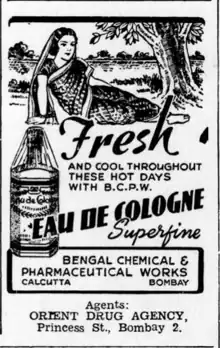Bengal Chemicals and Pharmaceuticals
Bengal Chemicals & Pharmaceuticals Ltd. (BCPL), formerly Bengal Chemical & Pharmaceutical Works Ltd. (BCPW), is an Indian central public sector undertaking under the ownership of Ministry of Chemicals and Fertilizers, Government of India.[2] lt manufactures industrial chemicals, pharmaceuticals like antibiotic injectables, tablets and capsules; and household products.[3]
 | |
 | |
| Formerly | Bengal Chemical & Pharmaceutical Works Ltd. (BCPW) |
|---|---|
| Type | Central Public Sector Undertaking |
| Industry | Chemical, Pharmaceutical |
| Predecessor | Bengal Chemical Works (1892–1901) |
| Founded | 12 April 1901 in Calcutta, Bengal Presidency, British India (now Kolkata, West Bengal, India) |
| Founder | Acharya Prafulla Chandra Ray |
| Headquarters | 6 Ganesh Chandra Avenue, Kolkata, West Bengal , India |
Key people | P M Chandraiah (MD) |
| Revenue | |
| Owner | Ministry of Chemicals and Fertilizers, Government of India |
Number of employees | |
| Website | bengalchemicals |
Established in Kolkata, West Bengal in 1901 by Prafulla Chandra Ray, it is India's first government owned-pharmaceutical-manufacturer. While initially successful, it started making losses in the mid-1950s. The management of the company was taken over by the Union government on 15 December 1977, and the company was nationalised on 15 December 1980.[2] Following decades of losses, BCPL returned to profitability in financial year 2016–17.[4][5]
History
Beginnings


In 1892, Prafulla Chandra Ray rented house at 91 Upper Circular Road, Kolkata and founded Bengal Chemical Works with a capital of ₹700 (equivalent to ₹270,000 or US$3,400 in 2023).[6] Ray founded the company as an individual initiative with the intention with fostering a spirit of entrepreneurship among the Bengali youth, and provide an alternative to jobs from the colonial British government. The company presented its herbal products the 1893 session of the Indian Medical Congress in Kolkata.[7]
The reputation of the company grew, and Ray added additional funds of ₹2 lakh (equivalent to ₹7.2 crore or US$900,000 in 2023) to the company to increase the scale of production. The business was converted into a Limited Company, and on 12 April 1901 the company was renamed Bengal Chemical and Pharmaceutical Works Ltd. (BCPW), retaining the same premises at 91 Upper Circular Road, Calcutta.[6][8] In 1908, John Cumming wrote in the "Review of the Industrial Position and Prospects in Bengal" that the "enterprise shows signs of resourcefulness and business capacity, which should be an object lesson to capitalists of this province".[7]
From a beginning with one factory in Kolkata's Maniktala in 1905, three more factories were established – one in Panihati in 1920, one in Mumbai in 1938, and one in Kanpur in 1949, with its registered office at 6 Ganesh Chandra Avenue, Kolkata.[6]
Struggles and nationalisation
The company began to struggle after Roy's death in 1944, and started making losses in the mid-1950s. The management of the company was taken over by the Union government on 15 December 1977, followed by nationalisation on 15 December 1980. The new public sector undertaking was named Bengal Chemicals & Pharmaceuticals Ltd. (BCPL), and was launched on 27 March 1981.[2][5] As its losses continued, BCPL was referred to the Board for Industrial and Financial Reconstruction in 1992.[9]
Return to profitability
After incurring losses for decades, the company managed to return to profitability in financial year 2016–17,[5] and continued to report profits for 2 subsequent fiscals.[9][4]
Hydroxychloroquine production during COVID-19 pandemic
In view of the Indian Council of Medical Research recommending hydroxychloroquine for prophylaxis against COVID-19, BCPL received clearance to start manufacturing the drug.[10][11][12]
Products
- Division I (Industrial Chemicals) - alum, bleaching powder[13][14]
- Division II (Pharmaceuticals) - generic drugs, such as analgesics, antipyretics, antimicrobials (including antifungals, antibiotics and anti-tubercular drugs) and antiseptics; and branded drugs like Ray Cal (calcium with vitamin D3 and vitamin B12) and Hospitol (chloroxylenol)[15][14]
- Division III (Home Products) - toiletries and household disinfectants[16][14]
Privatization
On the 9th of February 2021, the Government of India announced the privatization of Bengal Chemicals and Fertilizers.[17]
References
- "38th Annual Report 2018-2019" (PDF). Retrieved 23 June 2020.
- "BCPL Today". Bengal Chemicals & Pharmaceuticals Ltd. Retrieved 23 June 2020.
- "Bengal Chemicals Net at Rs 8.91cr, eyes Rs 200cr sale in FY'20". The Times of India. Press Trust of India. 5 April 2018. Retrieved 23 June 2020.
- "Financial Results 2018-19" (PDF). Bengal Chemicals & Pharmaceuticals Ltd. Retrieved 23 June 2020.
- Rakshit, Avishek (13 April 2017). "Bengal Chemicals posts profit after 63 years". Business Standard. Retrieved 23 June 2020.
- "History of BCPL". Bengal Chemicals & Pharmaceuticals Ltd. Retrieved 23 June 2020.
- Bhattacharya, Snigdhendu (13 April 2017). "How India's oldest pharma company smelt success after 6 decades". Hindustan Times. Retrieved 23 June 2020.
- Das, Soumitra (7 December 2020). "Chemistry of nationalism". The Telegraph. Retrieved 23 June 2020.
- Special Correspondent (1 May 2019). "Bengal Chemicals FY19 profit jumps 150% to ₹25 crore". The Hindu. Retrieved 23 June 2020.
- "Coronavirus crisis: India's oldest pharma PSU gets nod to make hydroxychloroquine". Business Today. 10 April 2020. Retrieved 23 June 2020.
- Khanna, Rohit (11 April 2020). "Drug green light for West Bengal Chemicals". The Times of India. Retrieved 23 June 2020.
- Singh, Shiv Sahay (10 April 2020). "Bengal Chemicals gets COVID-19 drug boost". The Hindu. Retrieved 23 June 2020.
- "Industrial Chemicals". Bengal Chemicals & Pharmaceuticals Ltd. Retrieved 23 June 2020.
- "38th Annual Report 2018-2019" (PDF). Bengal Chemicals & Pharmaceuticals Ltd. Retrieved 23 June 2020.
- "Pharmaceuticals". Bengal Chemicals & Pharmaceuticals Ltd. Retrieved 23 June 2020.
- "Home Products". Bengal Chemicals & Pharmaceuticals Ltd. Retrieved 23 June 2020.
- "Govt has decided to shut 2 pharma PSUs, disinvest other 3: Govt tells LS". Business Standard India. Press Trust of India. 9 February 2021.